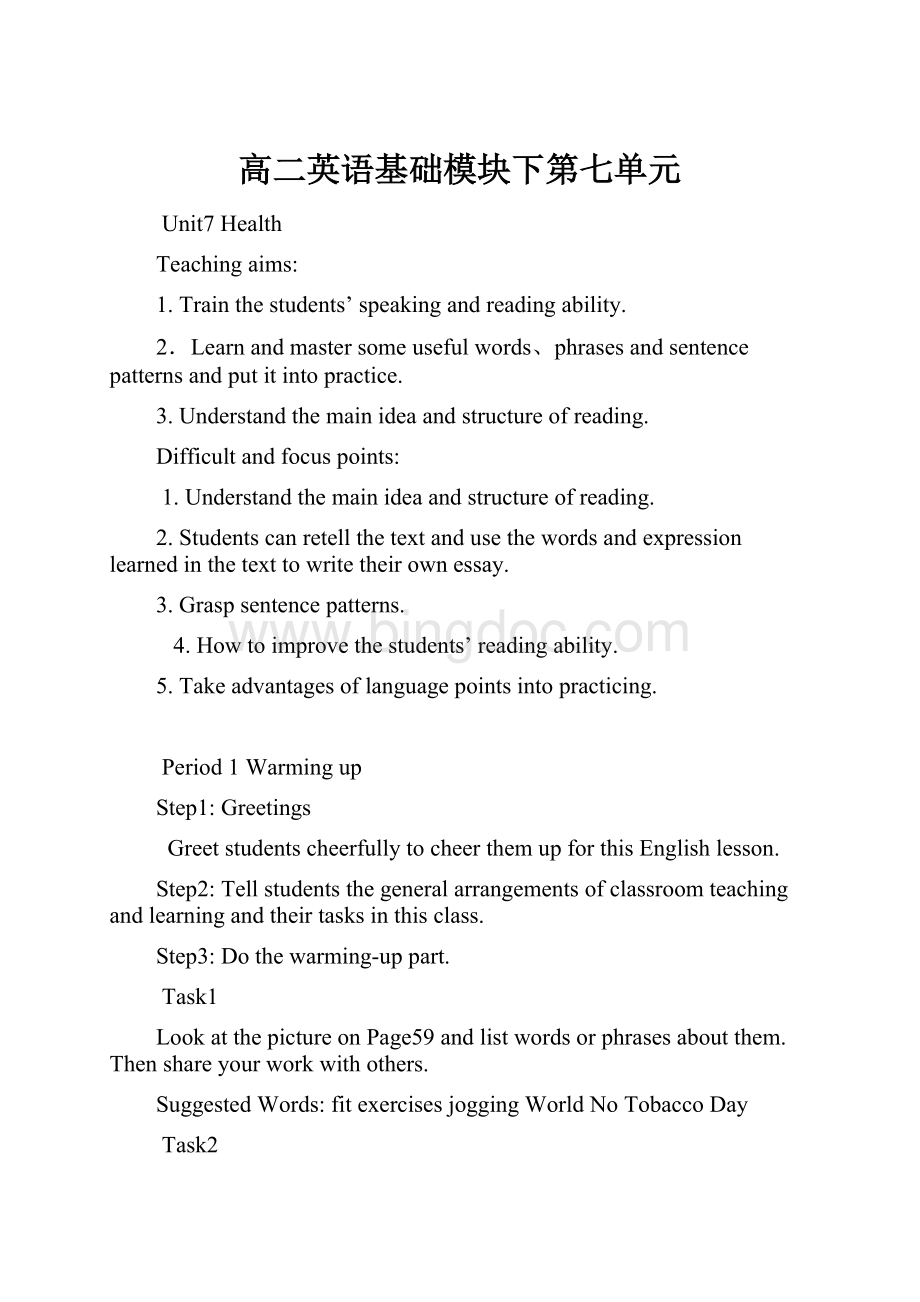高二英语基础模块下第七单元.docx
《高二英语基础模块下第七单元.docx》由会员分享,可在线阅读,更多相关《高二英语基础模块下第七单元.docx(11页珍藏版)》请在冰点文库上搜索。

高二英语基础模块下第七单元
Unit7Health
Teachingaims:
1.Trainthestudents’speakingandreadingability.
2.Learnandmastersomeusefulwords、phrasesandsentencepatternsandputitintopractice.
3.Understandthemainideaandstructureofreading.
Difficultandfocuspoints:
1.Understandthemainideaandstructureofreading.
2.Studentscanretellthetextandusethewordsandexpressionlearnedinthetexttowritetheirownessay.
3.Graspsentencepatterns.
4.Howtoimprovethestudents’readingability.
5.Takeadvantagesoflanguagepointsintopracticing.
Period1Warmingup
Step1:
Greetings
GreetstudentscheerfullytocheerthemupforthisEnglishlesson.
Step2:
Tellstudentsthegeneralarrangementsofclassroomteachingandlearningandtheirtasksinthisclass.
Step3:
Dothewarming-uppart.
Task1
LookatthepictureonPage59andlistwordsorphrasesaboutthem.Thenshareyourworkwithothers.
SuggestedWords:
fitexercisesjoggingWorldNoTobaccoDay
Task2
UsethefollowingsentencepatternsandthewordsorphrasesfromTask1topracticeoralEnglishwithyourclassmates.
Howimportantisahealthlifetous?
Doyouthinksmokingisharmfultoourhealth?
Doyouknowhowtogiveupsmoking?
Doyouknowthatsmokingisnotallowedinpublicplaces?
Joggingisagoodwaytokeepfit.
Let’sgiveupsmoking.
Livingahealthlife,wecanenjoythelife.
Doingmorningexercisesisgoodforyourhealth.
Step4conclusion
Sspracticethenewwordsandsentenceswiththeirpartner.
Step5Homework
1.PreviewReading.
2.Copythenewwordsandsentences.
Perid2Reading
Step1:
Greetthewholeclass
Step2:
Revision
Reviewthenewwordsandphraseslearnedlastclass.
Step3:
DealwithReading
Task1Skimming
Readthetextquickly;trytofindmainideaofthetext.
Task2Scanning
Readthetextagainandthenfinddetailedinformation.ThenfinishtheexercisesonP61.
Task3LanguagePointsandSentenceStructures
1not...anymore不再
Shedoesn’tlivehereanymore.她已经不住在这里了。
2smoke-free无烟的
Smoke-freearea无烟区
3afashionoftheday时尚,时代新潮
Bobhairisafashionoftheday.
4infact事实上
Ithoughttheworkwasdifficulttodo,infact,itwasveryeasy.
5havegood/badeffecton对什么有好/坏的影响
Thoughittasteterrible,themedicinewillhavegoodeffectonyourheadache.
6hundredsofthousandsof成千上万的,数十万的
7diefrom死于
Alotoffishdiefromwaterpollution.许多鱼死于污染。
8smoke-related与吸烟相关的
Smoke-relateddeathssmoke-relatedhealthproblems
9breathin吸入breathout呼出
Webreathinoxygenandbreathoutcarbondioxide.
10assoonaspossible尽快的
Step4Finishalltheexercisesafterthetext.
Step5
Reviewwhatwehavelearned.
Period3Grammer
Teachingaims
Ssshouldknowwhatthemodalverbsare.
Ssshouldmatertheknowledgeofhowtousethemodalverbs.
SscanusethemodalverbsintheirEnglishstudy.
Difficultandfocuspoints
Theusageofthemodalverbslikecan,should,will,mustandsoon.
Theminimaldifferenceofsomemodalverbslikecanandcould,may,shallandshould,willandwouldandsoon.
情态动词ModalVerbs
情态动词表示说话人对某一动作或状态的态度,认为“可能”“应当”“必要”等等。
它不能单独做谓语,必须和不带“to”的动词不定式(即动词原形)连用。
但beableto,haveto和oughtto则必须用to。
情态动词没有人称和数的变化。
有些情态动词没有过去式,如:
must;有些有过去式,如:
can-could;may-might;shall-should;will-would;haveto-hadto。
情态动词的否定式一般是在它们的后面加否定词not构成。
其简略形式如下:
can’t;couldn’t;mayn’t;mightn’t;mustn’t;shan’t;shouldn’t;won’t;needn’t等。
情态动词的基本用法
1.can、could和beableto的用法
①表示能力
can和beableto都表示能力,意思上没多大区别。
但can只有现在和过去时,而beableto则有更多的形式。
如:
HecanspeakEnglish.他会讲英语。
HecouldspeakalittleRussianwhenhewaslivinginRussia.当他在俄罗斯生活的时候会讲一点俄语。
Hisbrothercould(wasableto)takecareofhimselfwhenhewasten.他的兄弟在十岁的时候救能照顾自己。
②can(could)用来表示“可能”。
如:
Ithoughtthestorycouldnotbetrue.我认为这个故事不可能是真的。
Itcan’tbehim.不可能是他。
Anybodycanmakemistakes.谁都有可能犯错误。
Canyouseehimtonight?
你今晚能去看他吗?
③can(could)用来表示“允许”。
如:
Can/CouldIgonow?
我可以走了吗?
Youcanusemycomputer.你可以用我的电脑。
④can(could)用来表示请求。
此时can和could没有时间上的差别,could比can更显委婉客气,主要用于疑问句。
如:
Canyoulendmeyourbike?
你能把你的自行车借给我用一下吗?
--CouldIcomehereagaintomorrow?
我明天再来行吗?
--Yes,youcan.(--No,I’mafraidnot.)可以。
(对不起,恐怕不行。
)
2.may,might的用法
①表示“可以”“允许”。
如:
---MayIwatchTVaftersupper?
晚饭后我可以看电视吗?
---Yes,youmay.(--Yes,please.)可以。
---No,youmaynot.(---No,youmustn’t.---No,you’dbetternot.)不行。
HesaidthatImightusethetelephone.他说我可以用电话。
②表示推测性的“可能”。
如:
Hemaybeverybusydays.他这几天可能很忙。
Thestorymaynotbetrue.这个故事不像是真的。
③表示祝愿(不用might)。
如:
Mayyouenjoyyourself!
祝你们玩得好!
Mayyousucceed!
祝你成功!
3.shall,should的用法
Shall与should用作助动词时,should是shall的过去式;用作情态动词时,shall和should是两个不同的词。
①在疑问句中,情态动词shall用于征求对方的意见或请求指示,常用于第一、第三人称。
如:
WhereshallIwaitforyou?
我在哪等你?
Shallwestartnow?
咱们开始行吗?
②情态动词Should表示劝告、建议,作“应该”讲。
其同义词是oughtto。
如:
Afterthat,youshouldlistyourworkexperience.然后,你应该把工作经历列出来。
Youshouldn’tfeelunhappy.你不应该感到不愉快。
Weshouldlearnhowtousecomputers.我们应该学习如何使用电脑。
4.will,would的用法
①情态动词will可用于各种人称,表示“意志”、“意愿”或“决心”等,否定式won’t+动词。
Iwilltellyouallaboutit.我会把全部内容告诉你的。
Wewillhelphimifheasksusto.他要求的话,我们愿意帮助他。
Comewheneveryouwill.你什么时候愿意就来吧。
②情态动词will用于疑问句中,常用在第二人称,表示说话人向对方提出“请求”或“询问”。
Willyougowithme?
你跟我一块走吗?
Willyougivehimamessagewhenyouseehim?
你见到他给我带个信好吗?
③would是will的过去式,表示过去时间的“意愿”“意志”,可用于多种人称。
Theysaidthattheywouldhelpus.他们说他们愿意帮助我们。
IpromisedthatIwoulddomybest.我答应尽我最大的能力去做。
④would可指现在时间,表示意愿或向对方提出请求,语气比will委婉。
Wouldyoumindholdingthehandleforme?
你替我拿住这个手柄好吗?
Wouldyoulikesometea?
你想喝茶吗?
I’d(would)liketoseeyournewdress.我很想看看你的新衣服。
5.must,haveto,oughtto的用法
①must表示“必须”,强调主观看法,只有现在时形式,其否定式是mustnot(mustn’t),表示“不许”“一定不要”。
如:
Theworkmustbefinishedassoonaspossible.这项工作必须尽快完成。
Youmustn’tparkyourcarhere.车不能停在这里。
对must开头的问句,其否定回答要用needn’t或don’thaveto,表示“不必”,不能用mustnot.
---MustIcomebackhomebefore6pm?
我必须晚六点以前回到家吗?
---Yes,youmust.是的。
---No,youmustn’t./No,youdon’thaveto.不必。
/不用。
Must表示“一定”“必定”,是一种很肯定的推测,但只用于肯定句中。
在否定句中使用can’t,意为“不会”。
如:
---Whoisthereatthedoor?
门口的那个人是谁?
---Itmustbemybrother.一定是我兄弟。
---Itcan’tbeyourbrother.ItmustbeXiaoLi.不可能是你兄弟,一定是小李。
XiaoLiudidn’tcometoclass.Hemustbeill.小李没有来上课,他一定病了。
②haveto表示“必须、不得不”,在意义上与must很接近,但must表示的是说话人的主观看法,而haveto表示的却是客观需要。
Haveto比must有更多的时态形式。
Imustgonow.(主观意图)我得走了。
Ihavetogonow.Someoneiswaitingforme.(客观需要)我必须走了,有人等我。
Hesaidhehadtofinishthepaperbyhimself.他说他必须自己完成这篇论文。
Youdon’thavetoworryaboutthat.你不必为此事烦心。
Thestudentswillhavetoknowhowtousecomputers.学生们得学会如何使用电脑。
在口语中有时使用havegotto,如:
I’vegottogonow.
③oughtto无人称和时态变化,表示”应当”、”应该”,相当于should,否定形式为oughtnotto(oughtn’tto),如:
Yououghttotakecareofyourself.你应该自己照顾自己。
Suchthingsoughtnottobedone.这种事不能做
Exercise
1.MyfriendJohn________tosmoke,butnowhedoesn’t.
2.You_________drivecarefully.Theroadistoonarrow.
3.He_______liveinthecountryside,sohewas_________hardwork,butIamnotusedto.
4.She_______bringmelittlepresentswhenshecametoourhouse.
5.——CouldIborrowyourdictionary?
——Oh,ofcourseyou_________.
6.MotheraskedTomtohelpcook,buthe_________.
7.YoumusthaveseenthemovieTitanic,_______you?
8.Excuseme,______Ispeaktoyourheadmaster?
9.Youlookhappy.You________(have)agoodtimeattheparty.
Nomatterhowheavytherainwas,she_______giveupattendinghislecture.
Period4Listening
Teachingmaterialanalysis
Thelisteningmaterialsuppliesusaconversation.Thetopictheyaretalkingisaboutsmoking.
Teachingmethodsandlearningmethods.
Teachingmethods
a.Knowledgepresentation.
b.Discussion.
Learningmethods
a.Listentothetape.
b.Discusswithpartner.
Teachingprocedures
Step1.Greeting.
theSsatthebeginningoftheclass.
Step2.Leadin.
Theteacherletthestudentsguessthemeaningofthepicture.
Thepurposeofthedesignistoinspirethestudents’curiosityaboutthecontent.
Step3.ListeningPractice
Theteacherplaythetapeforthefirsttime,studentscanunderstandthemainmeaningoftheconversation.
Theteacherplaythetapeforthesecondtime,studentsfinishthepassage.
Step4.AnswerthequestionsonP63
Studentshearashortconversationonthetapeandanswerthequestions.
Studentscanmasterthephrasesfromthepractice.
Period5ReadingSpeakingandWriting
Teachingaims:
1.Mastertheopiniononhowtoexpress“Forbiddingandwarning”andtherelativeusefulexpressions;
2.Studentscandiscusswithhispartnersaboutthetopic.
Teachingimportantpoints:
Mastertheopiniononhowtoexpress“Forbiddingandwarning”andtherelativeusefulexpressions;
Teachingdifficultpoints:
Howtotalkabouthowtobehealthy.
Teachingmethods:
Task-basedmethod,role-play
TeachingAids:
CAI,chalks
Teachingprocedures:
Step1Lead-in
Greetthessasusual.
Step2Readingbyrole-play
.Dividethestudentsintofourgroupsandthenreadbyrole-play.
Step3.LearnandconcludetheusefulexpressionsaboutProhibitionsandWarnings
Mindyourhead/steps
Bequickoryou’llbelate
Don’tsmokeoryou‘llbefined
Becareful!
Don’ttouchthewire.
Keepawayfromthefire
Watchyoursteps
Youmustn’tdothathere.
Noentry.
Nospitting.
Nolittering.
Caution:
WetFloor
Danger:
DeepWater
Danger:
Noswimming
\Step3:
Writing
Task3Writeoutthemeaningofthefollowingsignsinwords
Noparking
Keepout
Staffonly
Nosmoking
Noleft-turning
Noturning
Step5Homework
AsktheSstopracticethedialoguewiththeirpartnersafterclass.